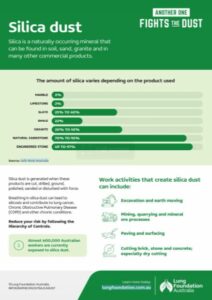Silica dust is a hazardous airborne substance generated when materials containing crystalline silica—such as soil, sand, granite, and engineered stone—are cut, drilled, ground, or disturbed. This infographic, developed by Lung Foundation Australia as part of the National Silicosis Prevention and Awareness Campaign, highlights the dangers of silica dust exposure and is especially relevant for workers in high-risk industries such as construction, mining, quarrying, manufacturing, and tunnelling.
Currently, nearly 600,000 Australian workers are exposed to silica dust, making education and prevention critical. Silica is found in a wide range of materials, with varying concentrations:
Engineered Stone: Up to 97% silica
Natural Sandstone: 70–95%
Granite: 20–45%
Shale: 22%
Slate: 25–40%
Limestone and Marble: Around 2%
Common work activities that generate silica dust include excavation, earthmoving, paving, surfacing, and cutting or drilling stone, brick, and concrete—especially when performed dry. These tasks release fine silica particles into the air, which can be easily inhaled.
Health risks associated with silica dust exposure are serious and often irreversible. Inhalation of silica particles can lead to:
- Silicosis: A progressive, incurable lung disease
- Lung Cancer: Long-term exposure significantly increases risk
- Chronic Obstructive Pulmonary Disease (COPD): A group of lung conditions that obstruct airflow
- Other Chronic Conditions: Including rheumatoid arthritis and chronic kidney disease
To reduce exposure, workplaces should implement the Hierarchy of Controls, including eliminating hazardous materials, using engineering controls like ventilation and water suppression, and providing personal protective equipment (PPE).
Lung Foundation Australia have developed industry tailored resource for people working with silica containing materials, as part of our National Silicosis Prevention and Awareness campaign. You can find resources for the construction, manufacturing, mining /quarrying and tunnelling industries. For more information, resources, and support, visit lungfoundation.com.au.
Was this page helpful?
Good job! Please give your positive feedback
How could we improve this post? Please Help us.
